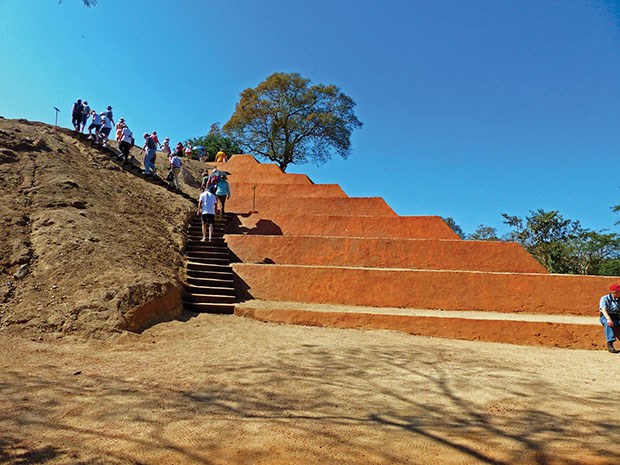Cruise ship tenders shuttle us across sparkling cobalt waters to Zihuatanejo’s docks. And joining fellow history buffs aboard a waiting tour bus, we head out into the Mexican countryside. Within 30 minutes, we’re standing inside Xihuacan (she-wha-cahn) Museum, keen to investigate this archeological site open since in 2013.
“Rainstorms would regularly expose relics,” says Ramon, our guide. “So villagers around here have long known about these ruins.”
Shepherding us through wondrous exhibits in glass cases, he continues, “These ceramic figurines, the jewelry, copper axes, carved seashells and bell necklaces all reflect the works of five cultures.”
Archaeologists have determined that Aztec, Toltec, Olmec, Zapotec and Tarascan tribes settled here between 450 BC and 1100 AD. Ramon identifies the most significant of the over 800 artifacts, including slats for flattening infant skulls into noble profiles. A polychrome vase even suggests that Mayans travelled from their far away lands to meet and trade at this 3,000-year-old site.
A detailed relief map depicts temples, ceremonial altars, ball courts, pyramids and villages once stretching across 2,000 hectares. So far, just a small part has yet been excavated.
Meaning ‘place of the people who control eternity,’ Xihuacan was a special religious destination where distant tribes gathered for sacred ceremonies. Unlike other early ceremonial centers in Mexico, this one was used to worship many gods.
“A prominent circular stone found here,” Ramon says, “was used for human sacrifices. Offerings were made twice per season to ensure the gods granted rain, fertility and bountiful crops.”
Before leaving the museum, an illustrated Mayan calendar helps everyone figure out their animal spirit. Applying birth dates to the 26 possibilities, many of us happily discover our deer, rabbit and bird spirits. Others groan at the revelation that their’s are snakes, spiders and lizards.
A dusty, rutted road behind the museum leads us to the newly excavated ball court amid scrub forest.
“At 54-meters long, this one is said to be Mexico’s second largest, after Chichen Itza’s famous court,” Ramon reports.
Fans would watch the revered ball game from surrounding slopes. Using only hips and shoulders, elite players bumped a heavy rubber ball through a stone ring high up on the wall.
A royal palace lying near the ball court will soon be excavated. As with all this site’s structures, it was covered with tons of sand long ago when a huge tsunami rolled in from the Pacific.
Further down the road rises a huge, nine-stepped square-based structure, each side measuring the length of a football field. Unique among Mexican pyramids, this one was built with adobe blocks. Reconstructed and coated with bright orange-ochre clay, it is amazing!
Steep wooden stairs take us 37-meters up to the pyramid’s flattop. Here, we discover worthy souls were prepared for sacrifice in a pool filled pure water and fragrant flowers. Some think the winning-or maybe the losing-ball players may have taken their last baths there!
Back aboard the bus, we roll past mango and palm plantations.
Stopping at a work yard piled high with drying coconuts reveals a small brickworks operation.
There, we meet a single worker kneading and forming clay into tiles.
He proudly tells us he produces up to 400 terra cotta tiles and bricks daily, firing them in his small mound kiln fueled with coconut husks.
A roadside restaurant farther on provides another welcome stop. After enjoying icy drinks, our bus carries us to a viewpoint overlooking Ixtapa, just six kilometers from Zihuatanejo. This glitzy twin sister boasts a string of luxury hotels arranged along a stretch of golden sand.
Returning to old Zihua, we bask in the warm breezes along Paseo del Pescador. Low-rise, fan-only hotels, boutiques, bars and galleries line the narrow cobblestone downtown streets. Pretty waterfront sculptures depict villagers at work; sculpted alligators lounge benignly in a small garden.
Countless beached fishing pangas remind us of the Shawshank Redemption, where Tim Robbins and Morgan Freeman dreamed of living Zihua’s ‘simple life.’
Even today, fishermen sell their red snapper catches to residents and restaurateurs from under shade trees just off the promenade.
And out in Zihuatanejo’s enormous bay, sleek sailboats and mega-yachts anchor where marauding pirates like Francis Drake once sheltered while plundering treasure-laden Spanish galleons up and down the Pacific Coast.
As others linger on patios drenched in late afternoon sunshine, we bargain with artisans for silver trinkets and hand-painted ceramics before catching the last tender back to our Veendam home.
Still a charming, laid back town, Zihuatanejo also proves the perfect gateway for our day trip into Mexico’s past.
Travel Writers’ Tales is an independent travel article syndicate that offers professionally written travel articles to newspaper editors and publishers. To check out more, visit www.travelwriterstales.com.



